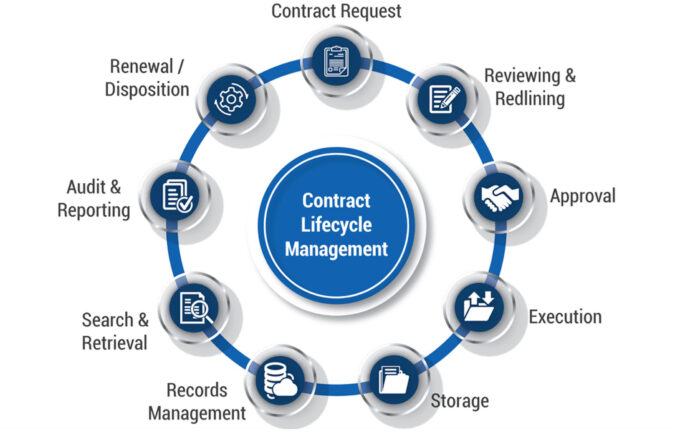Whether negotiating deals as a business owner or reviewing the fine print as a consumer, contracts are an inevitable part of modern life. But have you ever wondered what happens to agreements after signatures are signed?
Well, it turns out there’s a whole process involved in managing documents over their lifespan called contract lifecycle management. Keep reading for a peek behind the curtain at this important behind-the-scenes function.
What is Contract Lifecycle Management?

At its core, contract lifecycle management (CLM) refers to the steps involved in handling agreements throughout their entire existence within an organization. Rather than treating contracts as one-off transactions, CLM views them as long-term assets requiring continuous supervision. The primary stages include creation, negotiation, approval, execution, storage, management and analytics, and archiving.
During creation, contracts get drafted, negotiated, and tailored to satisfy both parties’ objectives. Legal and compliance teams scrutinize terms in the approval stage to minimize risks. Execution entails obtaining all necessary signatures bound by the deal.
Meanwhile, implementation happens when obligations take effect in day-to-day operations. Archiving stores contracts accessible for audits, renewals, and references down the line.
So, while it may seem like contracts disappear after inking, responsible organizations oversee important documents every step of the way. CLM ensures agreements get managed efficiently, strategically, and with emphasis on big and small details.
The Benefits of Centralized Contract Management

For organizations dealing with hundreds or thousands of contracts annually, coordinating has traditionally proven tricky without dedicated software. Documents languish in email inboxes or file cabinets awaiting someone’s attention. Version control issues lead to confusion or non-compliance. Timelines and milestones fly under the radar until it’s too late.
CLM centralizes the contract management process for increased visibility, control, and efficiency. Critically examining some key advantages illuminates why the practice has taken off in recent years:
- Improved oversight allows faster response to contract changes or expirations.
- Automated task and alert systems prevent missed deadlines or lapses.
- Templatized document creation speeds up negotiations and renewals.
- Real-time performance metrics offer data-driven management insights.
- Secure archives maintain oversight of historical agreements for audits or amendments.
- Anytime, anywhere access from mobile devices keeps critical documents at stakeholders’ fingertips no matter the circumstance.
By streamlining an inherently complex behind-the-scenes function, CLM creates opportunities for enhanced operational performance, cost-savings, and reduced risks company-wide.
Analyzing the CLM Stages in Detail

With a bird’s-eye view now established, let’s zoom in on the individual CLM stages to develop a more granular understanding of this end-to-end process.
Contract Creation
At the outset, key players collaborate on initial contract drafting. Legal counsel ensures compliance, while business owners focus on applicable terms. Standardized templates speed development whenever possible.
Negotiations refine sticky points. Once finalized, documents enter the formal management cycle.
Contract Negotiation

Once an initial contract draft is produced, discussion with counterparties often helps refine key deal points before final approval. During this iterative process, legal representatives from all involved firms collaboratively update contract language through open exchanges.
Keeping partners engaged helps address concerns, integrate valuable feedback, and eventually reach a consensus on mutual terms.
Approval Workflow
At this stage, predefined approval chains come into play based on contract type and departmental sign-off needs. Electronic routing and reminders facilitate efficient vetting by compliance, finance, and other relevant teams. Versatile workflow tools accommodate complex approval matrices.
Active Contract Maintenance
After execution, the real work begins. CLM systems automatically track performance requirements, provide alerts for upcoming reviews or expirations, and even trigger renewal processes. Dashboards and reports promote oversight of important portfolio metrics like spend or ROI opportunities.
Obligation Tracking & Performance

At the ground level, operational stakeholders consult CLM systems when fulfilling contractual duties or leveraging negotiated terms. Tracking tools ensure contract terms remain translated into routine business practices. Automated notifications keep teams apprised of changing needs over time.
Request Management
As contracts evolve post-signing, CLM streamlines amendment requests, addressing disputes, or exercising options through transparent, regulated processes. Stakeholder notifications build transparency throughout these critical adjustments.
Expiration & Renewal
Nearing closure, the CLM solutions support smooth transitions when deciding whether to renew contracts or source alternative partners. Automated reminder flows ensure sufficient lead time for strategic planning or procurement activities.
Archiving & Analytics

Finally, mature contracts rest within searchable archives. But the journey isn’t over – CLM tools extract granular insights to enhance future negotiations based on historical performance. Knowledge gets continuously harvested to optimize the process each time around.
Achieving CLM Maturity
As organizations advance in using technology-driven CLM practices, they progress along a maturity path spanning initial, managed, defined, and optimized stages. Initial adopters operate manually without oversight.
Managed firms recognize inefficiencies and invest in basic systems. Defined programs institute standard processes across the enterprise. In optimization, best practices get shared, and continuous improvements made. No matter the starting point, focused investments in CLM pay dividends.
The Future of Contract Lifecycle Management
Given the critical yet opaque nature of contract portfolios, automation represents the future of CLM. Emerging technologies show ongoing promise to reinvent this important behind-the-scenes function:
- Artificial intelligence parses existing documents to seed self-drafting systems.
- Blockchain immutably tracks sensitive terms between untrusted parties.
- Predictive analytics surface previously invisible insights for proactive management.
- Enhanced visualization marries control with intuitive usability across all devices.
While current solutions do have some structure, the innovations ahead aim to fundamentally reshape how organizations approach contracts – and their tremendous hidden value – for decades to come. With constant progress, CLM evolves to benefit enterprise stakeholders and customers through streamlined, strategic agreement handling at every turn.
In Conclusion
Examining the important yet overlooked area of contract lifecycle management provides insight into the behind-the-scenes work that turns agreements into long-term assets. Contracts evolve from negotiations through their entire lifespan within organizations.
Previously, this process lacked coordination and oversight. However, modern CLM platforms bring order and benefits by streamlining activities. They help formalize once vague contract handling processes.
Whether automating tedious manual work or standardizing systems, CLM solutions organize this critical yet complex part of business. As technologies advance, expect contract management to transform how enterprises operate through continuous enhancements. The improvements will optimize operations with each new software generation.









